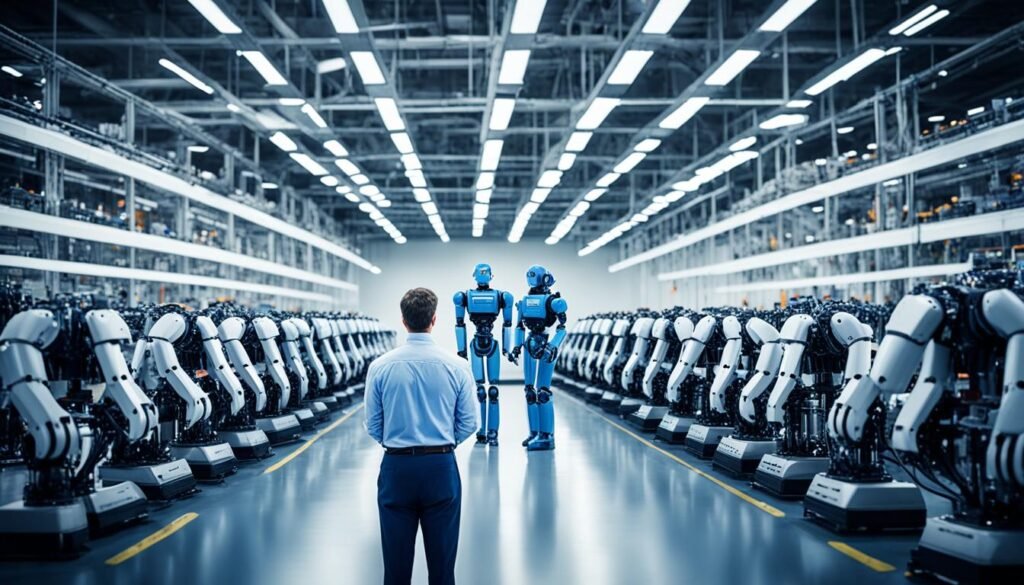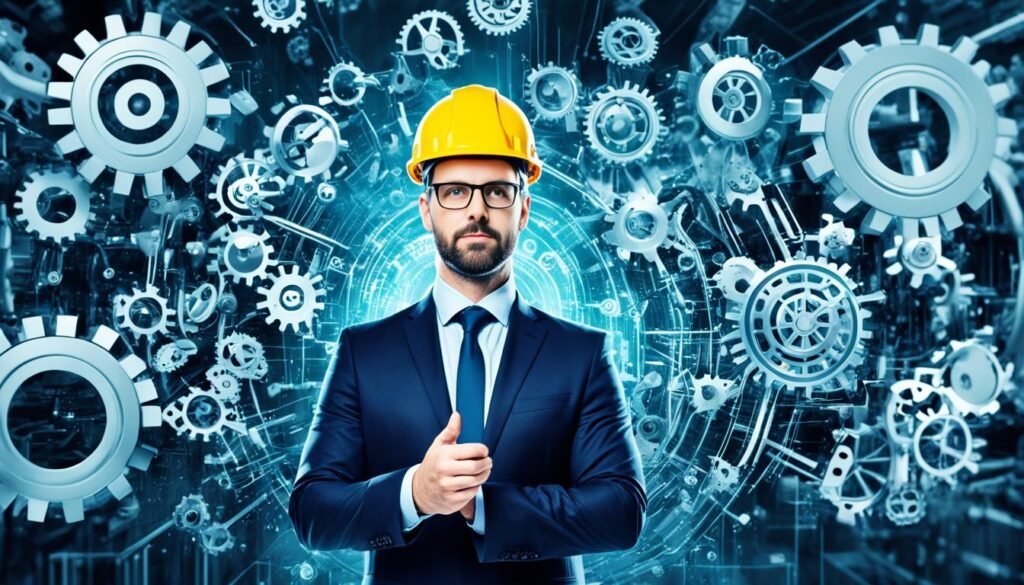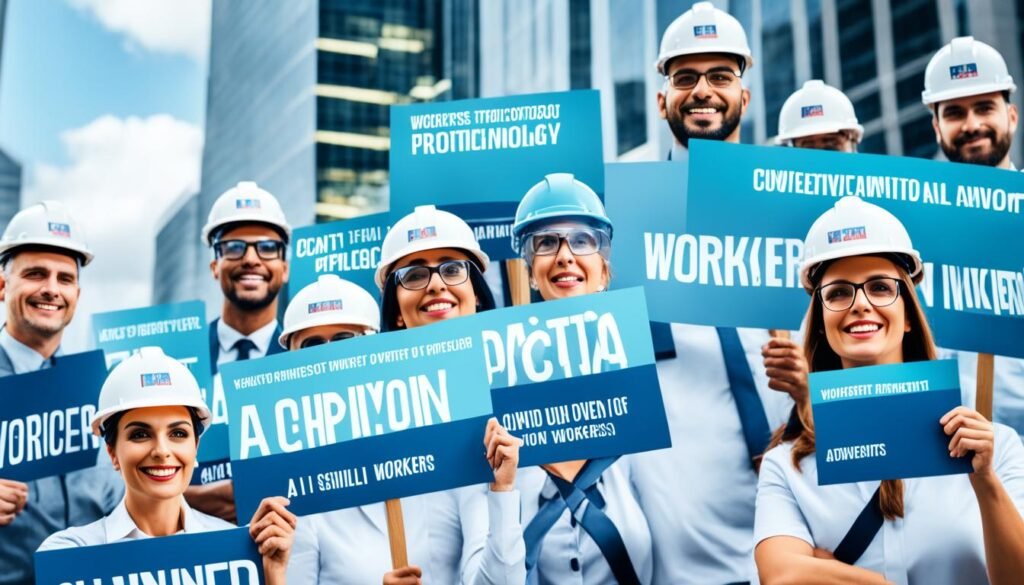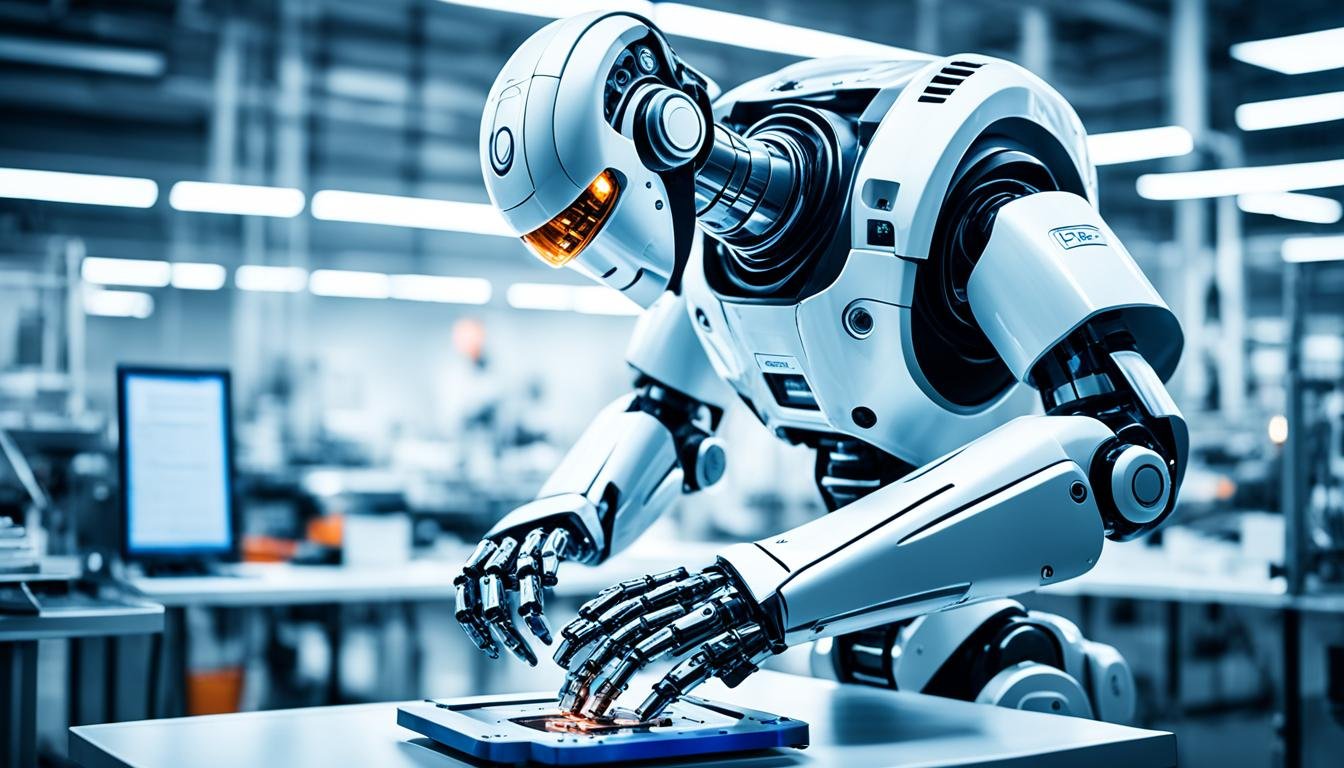Since 2000, automation has taken away 1.7 million manufacturing jobs. This shows how big of an impact artificial intelligence (AI) will have on the global workforce. The World Economic Forum says AI will replace 85 million jobs worldwide by 2025 but also create 97 million new ones.
This change will greatly affect the job market. Some jobs will be at high risk of being automated. Others will get better with AI technology.
As AI keeps getting better, it’s important to see how it will change work. We could see more inequality if jobs get automated. Or, AI could make tools that help us do our jobs better.
Key Takeaways
- AI is set to change the global workforce, possibly creating and eliminating millions of jobs by 2025.
- Jobs like customer service, driving, and programming might be at risk of being automated. But teaching, nursing, and creative jobs might not be as affected.
- How AI affects jobs depends on how it’s made and used. It could either replace jobs or make them better.
- Dealing with AI’s effects on jobs will need work from employers, workers, and policymakers.
- Learning and getting new skills will be key for workers to keep up with the changing job market and use AI’s chances.
Introduction to AI’s Impact on Jobs
AI technology is moving fast, making people worry about its effect on jobs. It can automate many tasks, which might replace jobs in different fields. This worry is shared by workers, employers, and those making policies, as they try to understand this big change.
AI’s Rapid Advancement and Its Potential Disruption
AI could add up to $15.7 trillion to the world’s GDP by 2030, showing its big impact. The World Economic Forum says 85 million jobs might lose out to AI and automation. But, they also think 97 million new jobs will come from the AI revolution, showing it’s a complex change.
McKinsey, a top consulting firm, believes up to 45 percent of work tasks can be automated. This includes simple tasks like data entry or answering customer questions. This change will affect many industries and jobs, leading to some jobs disappearing and new ones appearing.
Historical Perspective on Technology and Job Displacement
AI’s effect on jobs is not new. Throughout history, new technologies have replaced some jobs, but then created new ones. The power loom, steam engines, electricity, and digital computers are examples of past innovations that changed the job market. They led to new industries and jobs.
How AI affects jobs depends on who decides how to use the technology. AI can be made for many activities, and it could quickly change every part of our economy and life.
| Statistic | Value |
|---|---|
| AI’s Potential GDP Contribution by 2030 | $15.7 trillion |
| Jobs Predicted to be Displaced by AI and Automation | 85 million |
| New Jobs Predicted to be Created by AI Revolution | 97 million |
| Potential Work Activities that can be Automated | Up to 45% |
“The consequences of any technology, including AI, depend on who gets to make pivotal decisions about how the technology develops.”
AI Automation: The Path of Job Replacement
AI is moving fast, and it’s making us worry about jobs. The “just automate” approach means AI does tasks as well as or better than people. This has already hit American manufacturing jobs hard and made inequality worse over the last 40 years.
Negative Impact of Automation on Jobs
More AI automation could make things worse. It might widen the gap between the rich and the rest, making inequality bigger. It could also cut the number of good jobs around. Jobs that involve routine tasks or simple data work are at high risk of being taken over by AI.
Industries and Jobs at Risk of Automation
- AI can do bookkeeping tasks fast, sorting data and making reports.
- Robots are already doing jobs in manufacturing and warehouses, working faster and more accurately than people.
- AI can automate sales, which might replace some salespeople in stores and online.
- AI could replace editors in creative fields and is already used for checking content.
- It can predict trends in data, which might change some marketing jobs.
- AI might soon replace telemarketing with robocalls.
- AI and robots can help with farming, doing tasks like planting and checking crops.
- AI can help in retail by analyzing what customers like and answering their questions.
While ai job displacement, automation job loss, technology unemployment, and robot job takeover are concerns, AI hasn’t taken over many jobs yet. This is because many jobs need creativity, complex problem-solving, and the ability to interact with people.

The Augmentation Path: AI Enhancing Human Capabilities
AI is not here to replace human workers. Instead, a new path is taking shape – the “augmentation” path. This path aims to make AI tools that boost human productivity and skills. It helps a variety of workers, from those in factories to teachers and healthcare professionals.
AI as a Productivity Tool for Workers
AI can make workers more efficient and accurate in many fields. For example, AI tools in healthcare can look at thousands of medical images faster and more accurately than doctors. In manufacturing, AI robots can do tough tasks safely, cutting down on injuries.
In creative fields, AI can sift through huge amounts of data to spark new ideas. This helps workers be more creative.
A study by MIT found that workers using ChatGPT, a language model, were 37% more efficient. This shows how AI can change the game for workers, helping them do their jobs faster and better.
Potential for New Job Creation and Skill Development
The augmentation path also means new job opportunities and skill development. As AI handles routine tasks, workers will move to jobs that need creativity and problem-solving. This shift is a chance to focus on skills that AI can’t easily replace.
Professions like personalized medicine, policing, and teaching could see big improvements with AI. The growth of online learning and big data in healthcare could also lead to new jobs and skills.
As AI gets better, it’s key to invest in training programs. This way, people can get ready for the changing job market. By focusing on skills that make humans unique, workers can keep up and excel in an AI-augmented world.
Challenges Facing the Augmentation Path
The tech industry is moving fast with artificial intelligence (AI), but a big challenge is here. It’s about putting workers first, not just cutting costs. Many managers see workers as costs to cut to make more money for shareholders. But, they don’t see how valuable workers are and how AI can make them more productive.
Another big issue is the focus on making automation tools instead of helping workers. Tech experts are working hard on making AI that can do many tasks on its own. This often means ignoring ways to help workers more. Changing this focus is key to making the better AI path work.
Management Mindset and Worker Prioritization
For AI to help more, managers need to change how they see workers. They should see workers as key to making things better, not just costs to cut. This means changing how companies use technology and labor together. By valuing workers and supporting their growth, companies can make the most of AI’s benefits.
Tech Industry’s Focus on Automation
The tech world is all about making things automated, with big names like Microsoft and Google leading the way. They’re making AI to replace human tasks. But, this focus on making machines do everything can leave workers behind. The tech world needs to focus on making tools that help workers, not just replace them.
Fixing these issues is crucial for AI to bring benefits to both companies and workers. By matching management views, tech goals, and worker needs, we can make a future where AI helps people do more.

“The integration of AI in white-collar jobs is on the rise, impacting knowledge-work. Chatbots like ChatGPT and generative AI tools can significantly reduce time spent on information-centric tasks.”
The Role of Labor in AI Adoption
As AI gets better and goes into more industries, the role of labor in its adoption is key. Workers know which parts of their jobs can be automated and which can’t. They need to be part of the decision-making to stop just focusing on cutting costs and to make sure everyone shares in the benefits.
Increasing Worker Voice in Technology Decisions
Letting workers have a bigger say in tech choices leads to smarter AI use. They bring insights that help companies make better decisions about AI. This can also stop companies from watching workers too closely, which hurts trust and morale.
Unions and Contract Negotiations for AI Integration
The Writers Guild of America strike shows how important tech issues are in contract talks. Unions can make sure AI is introduced in a way that protects workers and shares benefits fairly.
About 40 percent of jobs worldwide could be affected by AI, with advanced economies at the highest risk. In emerging markets, it’s 40 percent, and in low-income countries, 26 percent. As AI use grows, workers need to have more say in tech decisions.
By working with workers and unions, companies can handle AI better. This ensures tech benefits everyone and addresses worker concerns early on.
Government Policies to Support Pro-Worker AI
As AI technology gets better, governments must step in to help workers. They should use a mix of policies. This includes tax breaks for companies that hire more people and strong rules to protect workers from AI’s downsides.
Tax Incentives for Human Labor
Changing the tax system can help. Right now, taxes often favor machines over people. By making taxes fairer, governments can push companies to hire and keep more people. They could offer tax breaks for companies that hire more humans or tax AI use more.
Regulatory Oversight and Worker Protection
Regulators must make sure AI is used right in the workplace. They should set rules against AI in job watching or unfair decisions. It’s also key to listen to workers on how to use AI at work.
Also, governments should fund research on AI that helps people and workers, not just replaces them. This could mean creating a special AI center to help lawmakers understand this new tech.
With a balanced AI policy, governments can make sure everyone benefits from AI. This way, they can lessen the bad effects on workers and help create a fairer work future.

which jobs ai will replace in future
AI is changing the job world fast, making many jobs at risk of being automated. As AI gets better, it’s taking over tasks that humans used to do. Jobs like data entry and customer service are now at risk of being replaced by AI.
Routine and Repetitive Tasks Vulnerable to Automation
AI is great at doing repetitive tasks that need data processing and standard decision-making. Jobs like data entry, telemarketing, and basic financial reporting are likely to be automated soon. AI can do these tasks faster and more accurately than humans.
Potential Job Losses Across Industries
AI will likely affect many jobs across different industries, leading to job losses. A Goldman Sachs study says AI could change the jobs of 300 million people worldwide. Jobs in legal, finance, and customer service are especially at risk since AI can automate tasks like data analysis and customer service.
By 2030, a McKinsey study predicts that 12 million Americans might need to switch jobs due to AI. AI could automate up to 30% of work hours by then.
| Industry | Jobs at Risk |
|---|---|
| Legal | Paralegals, Legal Assistants |
| Finance | Financial Analysts, Personal Financial Advisors |
| Customer Service | Customer Service Representatives |
| Education | Teachers |
| Marketing | Market Research Analysts |
Tools like ChatGPT are showing how AI can do tasks like coding and writing. This is making the job market change a lot. Companies are looking into AI, which makes people worry about job losses in the future.
“Goldman Sachs predicts that 300 million jobs in the United States and Europe will be lost or diminished by AI technology by 2023.”
Jobs Resilient to AI Disruption
Many jobs might be replaced by artificial intelligence (AI), but some roles are more likely to stay safe. Jobs that need a lot of emotional intelligence and interpersonal skills are less likely to be automated. Also, creative and strategic professions are seen as less at risk.
Roles Requiring Emotional Intelligence and Interpersonal Skills
Jobs that involve a lot of human interaction and empathy are less likely to be taken over by AI. For instance, healthcare workers see empathy as key in patient care. About 90% of them value this skill highly. Healthcare jobs are also expected to grow by 15% from 2019 to 2029, much faster than average.
Teachers and educators are crucial in helping students grow socially and emotionally. AI might find it hard to replace them. The data shows that students with supportive teachers are more engaged and do better in school.
Creative and Strategic Professions
Jobs that need complex problem-solving and creative thinking are less likely to be automated. 91% of creative professionals think creativity is key for economic growth, and 94% believe it drives innovation. The arts and cultural sector added $919.7 billion to the U.S. economy in 2019, making up 4.3% of GDP.
Management, consulting, and strategic planning jobs often involve dealing with uncertainty and making complex decisions. These skills are hard for AI to match. As things get more complex, the need for creative and strategic professions will likely stay strong.
“The arts and cultural sector contributed $919.7 billion to the U.S. economy in 2019, representing 4.3% of GDP.”
As AI gets better, jobs that need emotional intelligence, interpersonal skills, creativity, and strategic thinking are more likely to stay safe from automation. These roles will likely be in high demand as the workforce changes with new technology.
Reskilling and Career Transitions
AI and machine learning are changing the job world. It’s clear that reskilling and career changes are key. Experts say AI will create more jobs than it replaces. But workers need to get the right skills to grab these new chances.
Importance of Continuous Learning and Skill Development
To keep up, workers must keep learning and improving their skills. Knowing about AI can help workers move into AI-focused jobs. They need to get better at tech, take online courses, and learn about the industry.
They should also get work experience and improve soft skills like critical thinking and teamwork.
Educational Opportunities for AI-Related Skills
We need more investment in digital skills training and education for the AI future. Online courses, bootcamps, and special degrees are popping up. They teach workers the skills needed for an AI-powered job market.
By taking these courses, workers can get ready for reskilling career transitions. They can also learn the continuous learning ai skills needed to do well in educational opportunities ai skills.
| Industry Trend | Percentage Change |
|---|---|
| Executives believe generative AI will disrupt customer and employee experiences | Over 60% |
| Workers fear their jobs becoming obsolete due to AI | 25% in 2024, up from 15% in 2021 |
| CHROs predict AI will replace jobs within 3 years | Over 70% |
| Automation estimated to displace 85 million jobs by 2025, leading to 40% change in core skills | 85 million jobs, 40% change |
| Executives estimate 40% of their workforce will need reskilling in the next 3 years | 40% |
| Financial services leaders believe at least half of their workforce requires upskilling in 2024 | Nearly 70% |
“The World Economic Forum estimated that by 2025, automation would displace 85 million jobs, leading to a 40% change in core skills for workers.”
Social and Economic Impact of AI on Work
Artificial intelligence (AI) is changing more than just jobs. It could bring big gains in productivity and economic growth. But, it also might make income inequality worse and lead to more job loss.
Productivity Gains and Economic Growth Potential
AI could add $15.7 trillion to the global economy by 2030, which is a 16% increase from now. This growth will mainly come from automation and new products and services.
Addressing Income Inequality and Job Displacement
But, AI also has a dark side. Up to 60% of jobs in advanced countries could be changed by AI, and 40% of jobs worldwide might be at risk. This raises big concerns about income inequality and job security. Governments, businesses, and people need to work together to make sure AI benefits everyone fairly.
FAQ
What jobs are at risk of being replaced by AI in the future?
Jobs with routine tasks, like in regulatory compliance or clerical work, might be taken over by AI. Also, jobs that involve simple data collection and writing could see AI replace them. The data shows AI could take over the jobs of 300 million people worldwide. In the U.S. and Europe, two-thirds of jobs could face some level of AI automation. About a quarter of all jobs might be fully done by AI.
Which industries and job types are most vulnerable to automation by AI?
Jobs at risk include customer service reps, receptionists, accountants, salespeople, and those in research and analysis. Warehouse workers and insurance underwriters are also at risk.
Are there certain jobs that are more resilient to AI disruption?
Yes, jobs needing high emotional intelligence and people skills, like teaching and law, are less likely to be automated. Creative and strategic jobs that solve complex problems are also less at risk.
What can workers do to prepare for the impact of AI on the job market?
Workers should focus on learning new technical skills and getting career training. Taking online courses and gaining work experience is key. Developing soft skills is also crucial as AI will need more research and teamwork. The data also suggests investing in digital skills training and education is vital for the future.
How will AI impact the overall economy and employment landscape?
AI could lead to big changes in the economy and jobs. It could add around trillion to global economic activity by 2030, making products and services more innovative. But, it could also widen the gap between rich and poor, affecting up to 60% of jobs in advanced economies.
